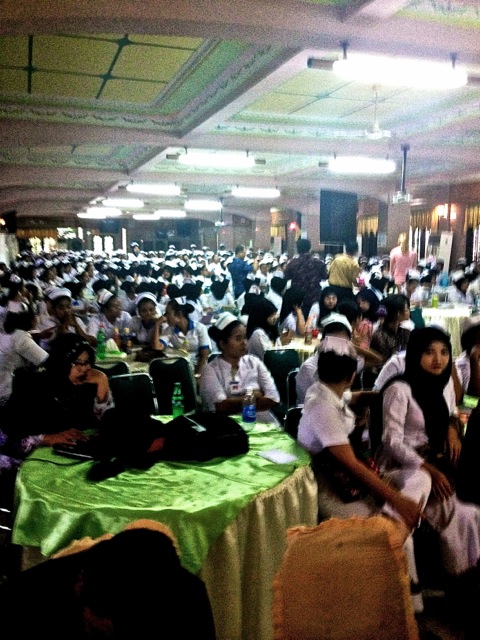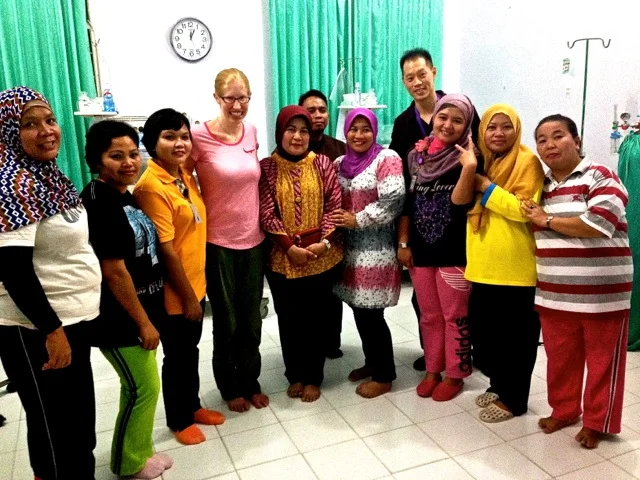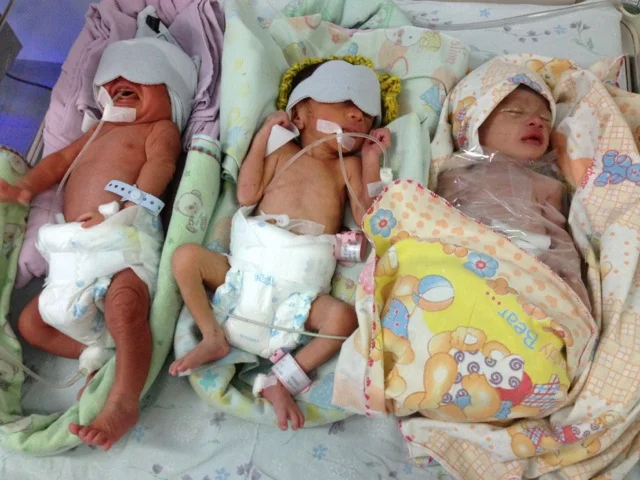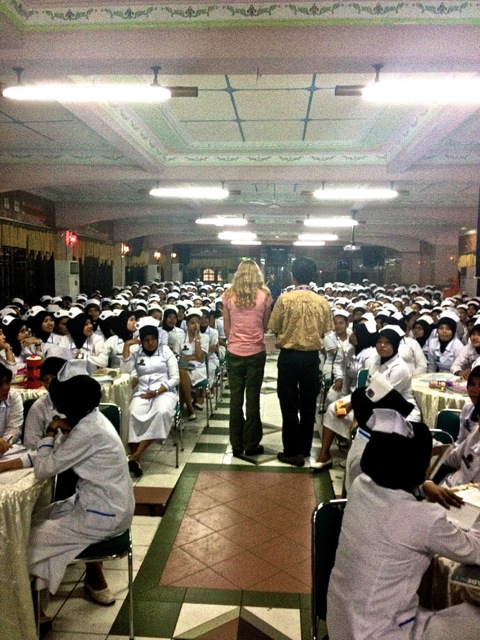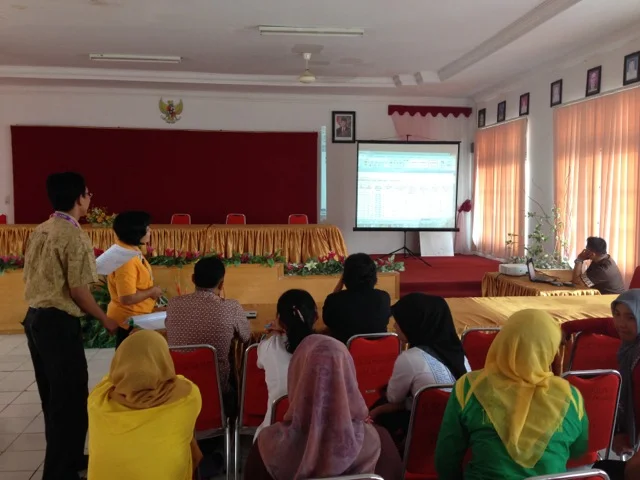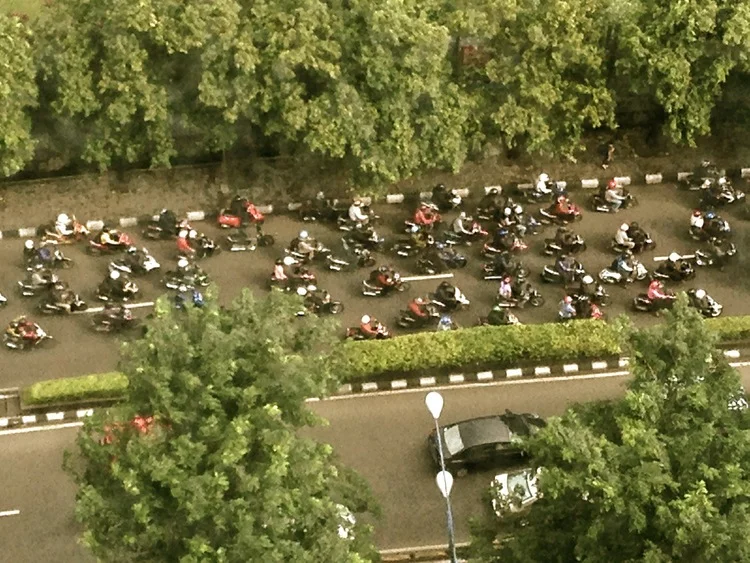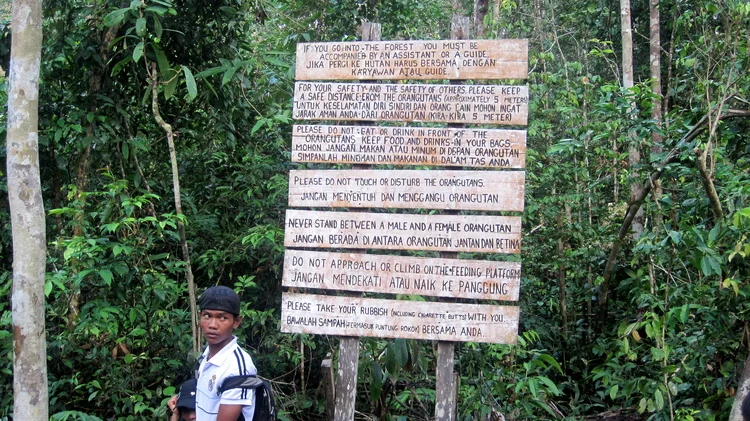Medan
Sembiring Nursing Students
There are four hundred nurses waiting in Sembiring’s lecture hall by the time Haley, Johan and I arrive for the talk we are to give. We were laughing but now duck through the building’s entrance in a respectful hush. We are surprised as much by the audience numbers as by the cavernous room, which spreads out to the opposite degree the roof squats short. The tunnel like architecture makes the nurse flow seems even greater. On the dais and in the distance, three video screens flicker, revealing among other images head shots of Haley and me, our respective positions and the talk title, “Sekit atau Sehat?” That morning when asked to provide the head shots, Haley and I joked about lightening things up a bit. I chose a picture of me dressed up as Yao Ming. Haley chose a picture of her playing piano in Europe with Barney. I am glad now that we ultimately decided not to risk being totally culturally inappropriate.
The clinical team has just come from Sembiring’s Neonatal Intensive Care Unit (NICU) where we are formally implementing decision support tools as the key strategy for decreasing maternal and neonatal death in EMAS facilities. This team consists of two Indonesian general doctors (Johan and Hendra), Haley, a volunteer pediatrician from the United States and myself. We have chosen two hospitals in North Sumatera for this activity, one private and one public, and one community health center with the only selection criterion being places where we won’t get kicked out. 150 hospitals and 300 healths centers to go. We are laughing because our intervention is working. In only two days we have mentored nurses to dramatically increase the weights of sick babies using a 16 dollar electronic scale, powdered formula to increase the calories of breast milk, and decision support tools at the bedside that take the guess work out of determining the babies’ feeding volumes. Our other decision support tools have helped the nurses determine when to discontinue unnecessary intravenous fluids and oxygen, which is about 80% of the time.
Nursing staff at RSUD with paediatricians
Everyone is excited. The team knows that simple weight gain will decrease mortality in the unit by more than 50%. Stopping the IV’s will prevent line infections and cases of accidental fluid overload. The nurses tell us that they feel empowered by this organization of care and they appreciate their new decision-making authority. Even the pediatricians value the time saved as they all carry three jobs and want to focus their time on “sick patients”. It is my last day in Medan and I am genuinely happy. Maybe the hospital director saw this feeling coming, because yesterday he asked if I would give a small talk to Sembiring’s nursing students before my departure.
“Pasti,” I said, “Of course.”
“We have kind of a famous nursing school,” the director said, “Sekolah perawat kami sedikit terkenal.”
“Great,” I said, “baik.”
The mass of nurses before us is both daunting and awesome. The scene is so unexpected. We had thought teaching a class meant 30 to 50 students. The nurses instead present as a health care army. They are all uniformed in white smocks and angular hats. Their posture is perfect and if not taking pictures and videos with their smart phones, their hands rest politely in their laps. Everyone is smiling and looking at us if about to receive a treat. As the team leader I bite the bullet and pick up the microphone.
“Halo,” I say attempting to speak in a manner suggestive of treats,” Kami berterimah kasih kepada anda semua menungu kami. Sekarang kami siap. Anda semua siap?”
“Ya!!!!!!!!!” a crescendo of yes’ rumbles the room, “We are ready.”
“Hari ini, kami akan bilang tentang pemeriksaan bayi,” I say, “anda semua tahu bayi adulah secara sederhana orang dewasa sangat kecil?”
“Tidak!!! No!!!” the nurses say, “Babies are not small adults. You can’t examine babies as if they are simply small adults.”
“That is right,” I say, “babies are not small adults and they must be treated differently and with care. When they become sick it is likely you will be there first. You nurses are with patients 24 hours a day and the medical system depends on you to initiate life-saving interventions and to notify the doctor when something is wrong. So how can you tell if a baby is sick? That is our topic for today. Begaimana tahu kelau bayi sekit atau sehat?”
The nurses look at me as if I am about to tell them. “Ini pertanyaan,” I say, “this is a question” and suddenly there is silence across the room.
I considered giving a talk on decision support, the reason for us being in Medan, but chose instead the topic of baby exam because I doubted whether I could explain the former. Maybe this means that our intervention is not as intuitive as I suggest. Maybe this means that I am a Bahasa Indonesian chicken shit. Whatever the engineering or my social block, I know deep down that decision support is the way we will improve the medical system here. My observation in Indonesia is that doctors are not present in sufficient number or with sufficient attention span to cover the patient load. There are 250 million people in Indonesia. As such, nurses and midwives, who are greater in number, have to pick up the slack but they don’t have the training or authority to do this.
Within a decision support structure, doctors agree that medical protocols must be followed, that medical protocols can be performed by other professionals too; that these protocols can be restructured in the form of intuitive checklists; that these checklists when located at the patient bedside dramatically increase the likelihood that they will be followed while providing a way to document that every patient gets the highest standards of care. It is not as if nurses and midwives are too dumb so as to necessitate decision support. Decision support assumes that there is too much information for all professionals in high stress high stakes environments to remember. There mistakes can be prevented by breaking down the steps of care like a chef does a recipe for a fancy dish, or a pilot does the safety routine before 747 take-off. The difference between decision support in medicine and that of other professions is that medical decision support was shelved long ago. We doctors are trained to think that we can remember everything so long as we study hard as medical students and work hard as residents. Just like on TV. After an albeit long schooling period, the medical system then only asks adult doctors to try their best. Oh airline pilot, just try your best. Oh five star restaurant chef, just try your best. Oh 9th grade science teacher, just try your best. The analogy applied to other professions makes this supposition kind of silly.
three lady bugs
I love babies. I think this as we show the nurses babies on the screen in various states of health. We are asking them what findings can help determine if a baby is sick or not sick, Sakit atau Sehat. I want the students to say vital signs, their general impression and physical findings centered around the eyes, skin, chest, and abdomen. It’s a little difficult to get audience participation in Indonesia. Students in Asia aren’t usually asked their opinion. So we select students at random which prompts a kind of evasive courage. Suddenly, no one is establishing eye contact with us speakers, but when selected the students take the microphone almost aggressively and stand up to face their peers.
“Halo my name is Erna,” our first contributor says using the English that she knows then reverting back to Bahasa, “ I thank you for teaching us. I am a nurse student. I think that baby is not well because it is black.”
Tetapi ini bayi dari Liberia,” I push, “This baby is from Liberia where people have darker skin.”
To this Erna pauses and purses her lips. “Well then from the skin color I then say the babies is fine.” Erna quickly sits down.
“Hmmm,” I say
“My name is Cici,” another student says, “My English not so good. This baby looks too straight and his eyes not open.”
“Ya,” I say, “you are noticing the baby’s posture. It’s not flexed like this.” I squat half-way down to the floor and bring up my foreams as if I am participating in a Jean Simmon’s aerobics video. “Ini posisi normal untuk bayi. This is a normal position for a baby. Good job.”
“Ahhhhhhhhhyahhhhhhhhhh!!!!!!!!!” a wave of cheers rushes across the room in support of their classmate. “Cici bagus!!!!!!!”
“Hi my name is Tomas,” one of the few male students says, “I am the best in my class. I am not from Medan. I think the baby is healthy because the posture is good, the skin is pink, the stomach is flat, I can’t tell if the baby is breathing fast because you show us a picture and not video.”
“Kalau Susu 36.5, ini akan mengantikan kasus ini?” I ask, “What if the temperature were 36.5, would this change your mind?”
“Uh, saya tidak tahu,” Tomas say, “I don’t know.”
“How would you know?” Tomas eyes are wide open as if he has just seen a baby ghost. “I would not guess.”
“I am glad you would not guess.”
“But I do not know.”
“I know you don’t know, but how could you know?
“I don’t know.”
“How about looking up what is a normal baby temperature in a book!!” I yell, “Mencari di buku atau di HP Anda semua!” Tomas looks an equal cross between confused, crestfallen and scared. I guess in Indonesia, teachers don’t yell.
Here are the calculations to determine the feeding volume and content of a baby weighing three pounds.
1.4 kg Baby
Source of feed: Breast Milk
Nutritional Requirements: 135kkal/kg/day to gain 10-30 g/kg/d
So 1.4 kg x 135 kkal/kg/d = 189 kkcal/d
Volume Breast milk: 189 kkcal/d x 30cc/20kkal = 283 cc/d
But 284 cc/d/1.4 kg = 202 cc/kg/d =
Too much volume!
So make 24 kkal/30cc breast milk
Recipe: 11.2cc spoon of powerder premature formula = 27kkcal.
So 4 kkcal = (11.2cc x 4)/27cc = 1.65cc
But who can measure 1.65cc!
So 1.65cc/30cc = 1.25 cc (a quarter teaspoon)/y cc. y = 23cc
So 1.4kg x 135 kkal/kg/h x 30cc/24kkcal = 236 cc
Give 236cc/hari x 1 hari/8 = 29.5 cc every 3 hours
Who can do this? What doctor has the time to make these calculations for 40 patients? Can enough people do this well enough to ensure that all babies get the nutrition they need regardless of the doctor taking care of them or the time or day of the week they fall ill?
Our solution is to do such calculations in advance and in graphical form. The nurse weighs the baby with an electronic scale and the chart gives exactly how much volume should be fed to the baby to achieve 135kkcal/kg/day. The form look like this:
Sample decision support tool
So on October 10th, if a baby weighed 1.745 kg, the nurse would put an “x” near the middle of the square next to 1.750 and make sure to give 45cc of breast milk every three hours. If the hospital has advanced capability and can supplement the milk with powdered formula, then the baby would receive 38cc every three hours. For the subsequent days, the babies weight would be recorded in adjacent boxes and different volumes of milk given. Over a range of days the nurse would connect the various “x’s” marked with a line and illustrate quickly in graphical form the rate of growth for the baby, which should again be between 10-20g/kg/d. Failure to hit this mark would lead to an audit of sorts. Was there an undiagnosed illness preventing weight gain? Was the milk being mixed correctly? Was it being given at the correct frequency?
Health care reform is hard anywhere (exhibit A: The United States and the recent hostage situation regarding the nation’s budgetary process) but Indonesia comes with its own particular considerations. First, Indonesia is the 7th largest economy in the world. This means that Indonesians tend to think they are more developed, and capable than their death statistics indicate. When exposed to the concept of decision support there is general agreement about its need but I am always asked, “Is this what you in the United States do?” To this a lie a confident, “Yes.”
Second, the country has 17,000 islands. This means that there is tremendous geographic disparity when it comes to access to quality health care services. How do you scale up robust clinical systems along such an expansive space? What do you do about dead-beat doctors in remote areas when there is no one to replace him/her? Doctors in Indonesia are like doctors in Liberia: So rare, they come almost entitled with questionable learning potential and in extreme cases pulse. Is no doctor better than a bad doctor? To this I say a qualified yes. But you better train someone else to do the job.
Finally, being in a country full of Asians, there is tremendous courtesy and deference to visitors, which can be mistaken for buy-in. One can think that progress has been made following serious, structured and lengthy interactions only to find months later the status quo. We Americans of course call this dynamic passive-aggressiveness. And, maybe I have experienced a type of Stockholm Syndrome in my seven months in Indonesia, but I don’t know what is better. The American way of hell no, red-faced argument, and no change; or the Asian way of maybe, let’s discuss, but please have the snacks and sweetened tea that we bring.
Haley and Johan teaching
Haley and Johan have now taken over the lecture. They are being asked questions from the student which range from what causes hemolysis (non-sequitor) to why do babies born to mothers with gestational diabetes often come out big (also non-sequitor). I am not sure if the students have gotten the point, though it is obvious they are enjoying themselves, which could be the point. After each question and answer, tens of other hands shoot up to be called upon. Haley and Johan try their best to answer the onslaught but non-sequitor questions with non-sequitor answers tend to drone on. As Johan translates each of Haley’s carefully constructed responses, I become acutely aware of cost in terms of time and accuracy. Make no mistake, Haley and Johan are great, but obviously common language and cultural understanding defacto makes things more efficient. This cannot happen within a three-week visit. But it’s a process too. Maybe this program with Boston’s Medical Centers will prompt volunteers to want to stay for longer periods in the future. Maybe our decision support tools are the lever that adds sufficient guidance and context to make this investment worth it. Only time will tell. This is only Medan. Next is Banten, Surabaya, Pinrang and that’s only the sites until mid-November.
“You are very beautiful,” a student says to Haley, “Anda cantik.”
“She says you’re beautiful,” says Johan to Haley.
“Teri..ma kas..i..hhhh,” responds Haley, “but what is your question?”
The students understand Haley’s “thank you” in Indonesian and cheer her on, “Sama sama they yell…You’re welcome!”
The student says quickly, “I just want to thank you for visiting us in Medan. That is all I have to say.”
The crowd applauds. It’s a dream crowd. One can do no wrong. But regardless Johan, Haley and I have worked hard to get here. I am just encouraged by the spirit of both the team, the students and their teachers. For the moment, no matter who we are and where we come from, we are one.
Nurses teaching doctors decision support


